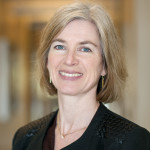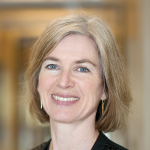 Berkeley scientists — including Biosciences’s Jillian Banfield (secondary affiliation with the Environmental Genomics & System Biology Division) and Jennifer Doudna (Molecular Biophysics & Integrated Bioimaging Division) — have discovered simple CRISPR systems similar to CRISPR-Cas9 — a gene-editing tool that has revolutionized biology — in previously unexplored bacteria that have eluded efforts to grow them in the laboratory. Read more at Berkeley News.
Berkeley scientists — including Biosciences’s Jillian Banfield (secondary affiliation with the Environmental Genomics & System Biology Division) and Jennifer Doudna (Molecular Biophysics & Integrated Bioimaging Division) — have discovered simple CRISPR systems similar to CRISPR-Cas9 — a gene-editing tool that has revolutionized biology — in previously unexplored bacteria that have eluded efforts to grow them in the laboratory. Read more at Berkeley News.
CRISPR Pioneers Runners Up for Time Magazine’s Person of the Year
Jennifer Doudna, faculty scientist in the Molecular Biophysics & Integrated Bioimaging Division and molecular and cell biologist at the University of California, Berkeley, together with four other CRISPR pioneers, were among the top five named runner ups of Time Magazine’s 2016 Person of the Year. They were chosen for their roles in the development of the CRISPR-Cas9 gene-editing system, a revolutionary tool that promises cures for many heritable diseases. It is the 90th time Time Magazine has named “the person who had the greatest influence, for better or worse, on the events of the year,” the magazine states; this year, they chose Donald Trump.
Doudna shares the recognition with Emmanuelle Charpentier at the Max Planck Institute in Berlin, Feng Zhang of the Broad Institute of Harvard and MIT , Carl June at the University of Pennsylvania, and Kathy Niakan at the Francis Crick Institute in London. Read more about their pioneering work in Time Magazine’s article, The CRISPR Pioneers, their breakthrough work could change the world.
The Golden Time to Do Hybrid Methodologies
The work of Eva Nogales and Jennifer Doudna, Molecular Biophysics & Integrated Bioimaging Division faculty scientists, were highlighted in the August 18 Nature technology feature article, “Let the structural symphony begin,” a discussion of the current “golden time to do hybrid methodologies,” according to Nogales. Structural biologists, such as Nogales who was interviewed for this article, now have “the tools to tackle important questions about cells’ molecular machinery that would have been impossible to answer just a few years ago.” Combining these imaging methods – selecting from an impressive suite of different imaging techniques – is an increasingly popular approach in the field of structural biology, in which X-ray crystallography has been the premier method for more than a century. According to the article, while “the most powerful insights come from (these) hybrid methodologies that integrate images from several different tools, ” it also has its drawbacks. Read the full article here.
Doudna Wins Tang Prize in Biopharmaceutical Science
Jennifer Doudna, faculty scientist in the Molecular Biophysics & Integrated Bioimaging Division, will share the prize with Emmanuelle Charpentier and Feng Zhang. They were honored “for the development of CRISPR/Cas9 as a breakthrough genome editing platform that promises to revolutionize biomedical research and disease treatment.” The awards, announced over the weekend in Taipei by Nobel laureate Y. T. Lee, each come with a cash prize of $1.24 million, in addition to funds for research. Read more at Berkeley NewsCenter.
Doudna Named Foreign Member of UK’s Royal Society
Jennifer Doudna, biochemist faculty scientist in Molecular Biophysics & Integrated Bioimaging, has been named a foreign member of the prestigious Royal Society. Doudna, who is also a professor of molecular and cell biology and of chemistry and a Howard Hughes Medical Institute investigator, was honored for “her work on CRISPR-Cas9 gene editing technology that is revolutionizing the fields of genetics, molecular biology and medicine.” She is one of 10 new foreign fellows and 50 new fellows who will be joining many of the world’s most eminent scientists in this scientific academy, which is dedicated to promoting excellence in science. Read the Royal Society announcement.
- « Previous Page
- 1
- …
- 3
- 4
- 5
- 6
- 7
- 8
- Next Page »
Was this page useful?







